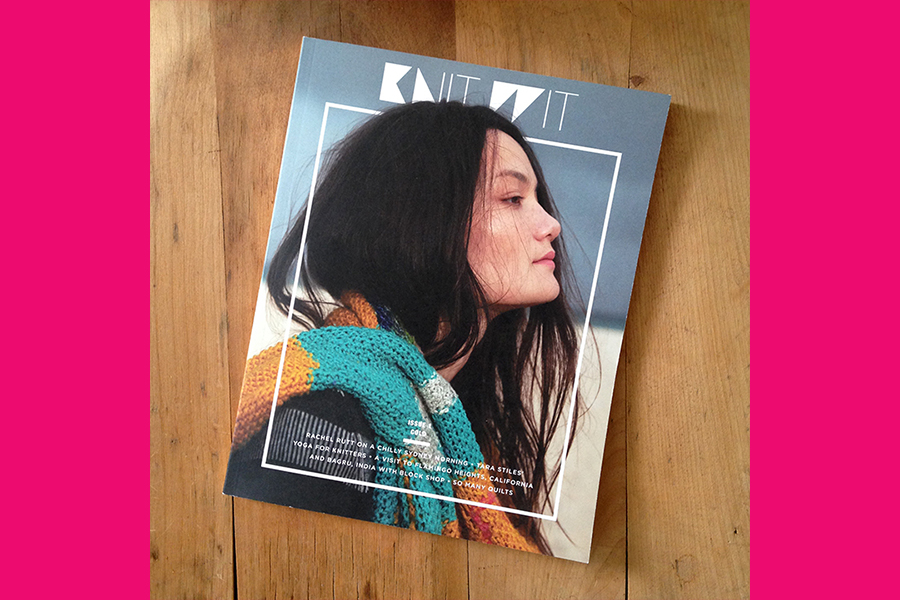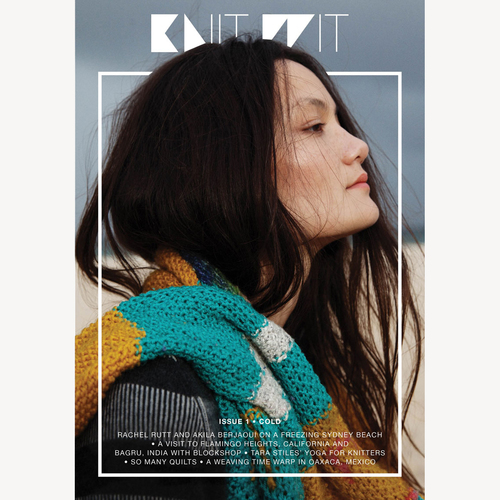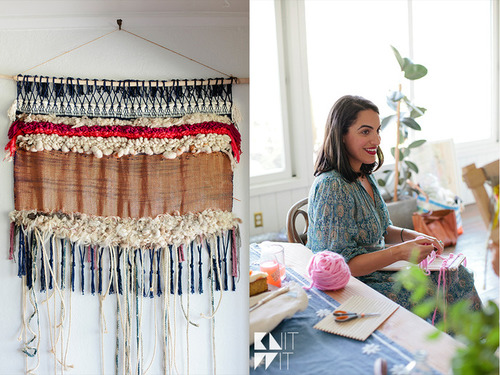A new contemporary textiles publication joins the ranks of print-focused lifestyle magazines.
by Joanna Demkiewicz
If Cherry Bombe reinvigorated all things foodie with its eye-candy spreads and storytelling approach to the food industry, then Knit Wit is on track to do the same for the textiles community. After raising more than $23,000 on Kickstarter in the fall of 2014 to launch their first print issue, co-founders Zinzi Edmundson and Gigi Jack have created a bi-annual print magazine and an online space that is an ode to the contemporary textiles and fibers community.
If you had no idea that a contemporary fibers world existed, you’re not alone. Edmundson, who has been knitting since she was seven years old, first launched Knit Wit as a knit-only zine. “[But] I discovered that it is such a deeper and richer community than I originally thought,” she told me. Her curiosity into the various aspects of fibers drives the magazine’s editorial voice, and Knit Wit’s content is broad – from studio visits to Patagonia, to the natural thread dyeing process, to wearing #socksandsandals.
I spoke with Edmundson, who serves as the magazine’s editor (and is also one part of the electro-pop duo Kisses with husband Jesse Kivel) about straying from the traditional magazine format; crocheted bikinis; and their sophomore issue, which will be released May 5.
Joanna Demkiewicz: You and Gigi [Knit Wit’s creative director] each come from traditional magazine backgrounds – you at Bon Appétit and Gigi at C magazine – and then you reconnected at FOAM, a women’s fashion and surf magazine [which has since folded]. To launch your own lifestyle magazine, what traditional methods did you pull from your past experiences, and alternately, in what ways do you stray from particularly traditional magazine practices?
Zinzi Edmundson: One thing we don’t do is that we don’t really have true sections. I found that a lot of times – this happened a lot at FOAM – it seems like you have a really strict rubric, and you’re trying to pitch stories for the regular features you do instead of being like, “This is an interesting story; let’s do a piece on it.” With strict sections, the mentality is like, “Well…is it right for this column? Or is it right for this column?” It’s like you’re always trying to find that right fit.
But we did want that traditional magazine pacing, so what we ended up doing is dividing it into three sections. We still kind of have a “front of book,” although we don’t rely on news pieces since we only come out twice a year; if we ran too many news bits, they would be moot by the time the magazine came out. That being said, we still do smaller stories like market pieces, Q&As and essays. And then features and editorials are placed at the end. But we don’t keep to a strict – “Every time we do books, every time we do a playlist, every time we do this.” It seems like you’re going through the motions to fill in those gaps at a certain point.
JD: I like what you said about the traditional magazine pacing. From the outside, it “looks” similar to other lifestyle magazines, but you’ve broadened the content you receive by not sticking to a too-specific format, right?
ZE: Yeah, and I think there’s also a certain comfort level we both have with that format because we come from traditional print magazines. It was easy for us to visualize how it would work in that way. Also it’s nice if people are used to a certain pacing, even if they don’t really know it or aren’t paying attention to that element.
JD: Knit Wit is only available in print, and in your Kickstarter mission statement, you said that as a print-only publication, “Knit Wit is [your] (re) declaration of [your] love of the tangible medium.” What do you say to those who preach that “print is dead”?
ZE: It’s expensive, let’s be real. It’s not as sustainable, or easily sustainable, as a website. It requires a lot of rigid deadlines and a lot of technical knowledge that is kind of rarified now. But Gigi and I were both in the digital space for awhile, writing for websites, and both of us worked in e-commerce, and we were both like, “Aw, man, I just want to make something again.” [Laughs] There’s been talk of this – and I hope it’s true – that it’s not just from the editor and creative side, it’s also from the consumer side that people do have a longing for a magazine that they can hold and spend time with and put on their coffee table. It has to change form – you know, what I said about the news bits, and how we cut that out of the magazine because there’s no way for us to keep up with the news. But I think there’s definitely room to have a point of view, and if the point of view is in print, and people don’t mind paying a premium for it, it seems sustainable in its own way. Obviously the price is expensive, but it’s its own market, its own economy different from what we’re used to, from the newsstands.
JD: Totally. People ask us all the time about our print element at The Riveter. I think people are choosier with what they buy, and now lifestyle elements – like home decor or even everyday fashion – include magazines that look really pretty and have a long shelf life.
EZ: I think people’s relationship to print is changing. The onus is on the magazine maker, editor and creative director to create something that someone will want to spend 20 dollars on. We’re hoping to make a magazine that matches the monetary value. It’s got a certain quality to it. I hope that comes through.
JD: I feel like you are reimagining the “online magazine” space by creating such vibrant Instagram and Pinterest accounts. Was this your intention in curating these social media platforms?
EZ: Yes, that’s totally intentional. We wanted to create a community instead of just churning out more content. Because also, we got into this trying to get away from that feeling, like, “Oh my God, it’s Wednesday, and on Wednesday we always do this.” We still want to have a conversation with the people that are interested in the magazine. We don’t want to be like trendsetters who come down from the mountain twice a year who are like, “Here’s what we think.” There should be a little more back and forth.
JD: Speaking of re-branding, your mission statement mentions that you are “repelled by the cutesy” and “fatigued by the heady.”
EZ: [Laughs] That was sort of violent language, so we’re launching a new site with some toned down language. People were like, “’Repelled?’ Ew, who do these people think they are?” We don’t mean to insult. Same idea, just different phrasing, is coming soon to a website near you.
JD: I feel like I get what you mean by that, though. Because, at least from an outsider, it does seem like most of the time when the textile or knitwear community is represented, there is a set aesthetic. Even though you are changing the language, can you talk a little about what you meant by your mission statement?
EZ: Basically, the reason we had the idea to start the magazine is because I’m a knitter, and I love to knit, but I just find that a lot of the stuff in the community isn’t my vibe – I don’t want to put names on it or whatever – but it doesn’t reflect an aesthetic that I feel a part of. I just wanted to make something that I felt represented what I love about the craft – beyond knitting as well. I do think there’s a certain element of the craft community that can be a little alienating or off-putting for newcomers. What we really wanted to do was to take the elements that we really like and the work that’s being done that we really like, and show it in a broader medium and invite people to be interested in it.
That’s why we don’t do things like include patterns or a lot of technical information, because it’s not really inviting. And that was something that we took from FOAM. Our editor there used to call it “a general interest niche title,” which is just taking something like women’s surfing and making it something that anyone would want to read about, whether you surf or whether you have never been to the ocean. That’s the idea with Knit Wit. That’s why we have ruffled a couple feathers in the past, but that’s ok, because hopefully we are accessing a different audience.
JD: I live in Minneapolis, so knits are like a second skin for most of the year. You live in Los Angeles, a much warmer climate. How do you incorporate knitwear into your daily life? I certainly was super inspired after browsing your “SUMMERTIME FIBES” Pinterest board, which really shows the versatility of knits.
EZ: Oh, yes. So many crocheted bikinis. Well, living in LA, there’s a lot of cotton involved. I recently had to email Jade [Harwood], who’s one of the founders of Wool and the Gang, to ask if it was possible to create a custom order using a couple of her patterns where I could incorporate cotton in her wooly patterns, because it’s just really uncomfortable to knit with wool here, unless you have your air conditioning cranked really high. I think here [in LA] a lot of the other crafts are more emphasized, like there’s a great dye community and weaving community. In terms of how we’re dressing – it’s not very knit-oriented because it’s hot. It’s really hot. So, we’re just admirers more than anything. I wish I could say I wore the crocheted bikinis on our Pinterest board, but sadly, I’m eight months pregnant, so that’s not going to happen. [Laughs] It’s funny, because I think there are some really great knit communities that are in hot places, like in Australia they’re doing some amazing things with knit, but I don’t know who’s actually wearing it, because it’s hot all the time.
JD: When you do wear knits, do you have a go-to look?
EZ: Like I said, I’m super duper pregnant, so my entire dressing philosophy has gone out that window. But we just shot some really beautiful things by Lauren Manoogian, a knitwear designer from Brooklyn, and she has the most beautiful Peruvian and Alpaca cottons. I feel like if it wasn’t blazing hot here, if we had a true spring, I would wear her delicate, knit jumpsuit with a skinny belt and cool, flat sandals. That’s my dream right now.
JD: You talked a little about this earlier, but what other facets of the textiles community does Knit Wit include, besides knitting, of course? Like the natural dyeing process you mentioned –
EZ: Originally, I was going to make a zine about knitting, like a single-author zine. So, I started an Instagram account for Knit Wit, and I started following a bunch of people, and then following people they follow, and seeing who they were tagging… I discovered that it is such a deeper and richer community than I originally thought, and that’s why I abandoned the knit-only idea and opened it up to different fiber aspects. In the winter, we focus more on knitting and dealing with wool, and we feature sheep-to-shelf companies that own their own ranch and produce their own garments. In the summer, it’s more about things you can do outdoors, like dyeing yarn, weaving, needlepoint and macramé.
We’re trying to keep it loose, too, just to get as much in there as we can. There’s this great fiber artist Cathy Hsiao, and she does a lot of weaving and natural dyeing. She uses her leftover dye and dyes concrete and ceramics – like pots and bowls. That was in our first issue because even though it’s not technically fiber art, it’s related and it’s a part of her process. Plus, it’s super interesting, so why not?
JD: What’s the most surprising thing you’ve learned about fibers and fashion since launching Knit Wit?
EZ: It’s made me more aware of the textiles in general. Every time there’s a new season, or a new collection out, it feels like I’m seeing different textures, and chunky wovens, and things like that coming up, and it feels like I’m more tuned into it. It’s been really fun to see it translated and see it through this seemingly myopic view of fiber art and then look at fashion and realize, “No, this is everywhere.” That’s not to say that all designers think about their textiles. Unfortunately, a lot of them don’t. But when they do, it’s super exciting.
JD: On that note, who are some of your favorite designers that you’re really looking at right now because they do pay attention to textiles in their collections?
EZ: We’re having Ryan Roche, a knitwear designer, in the new issue, and she’s been exploding everywhere. Her stuff is so pretty. We just went to Patagonia in Ventura County to visit their office, and they have a textile lab where they think about every detail about sourcing materials, and they also do the sheep-to-shelf thing. All of their fabrics go through a rigorous, scientific process; it’s like a mad science lab up there. They have all these different machines that test different qualities, and they develop a lot of their own things…it’s insane.
JD: Issue 1 takes us to India, Mexico, London and more. How do you find your subjects and how do you find your writers?
EZ: We find the subjects through curiosity and keeping an exhaustive Google document open just dumping ideas constantly. For Issue 2, now that we have something to show for ourselves, we were able to reach out to a lot of writers and photographers we like. The first issue was mostly – in terms of contributors – people we had worked with at FOAM or friends who are writers, photographers or stylists. We really just tapped into our community, which helped keep content broad instead of getting too deep into textile nerdland. Because of the variety of contributors, it has that magazine-y perspective.
JD: What are some of your favorite textile or design magazines, or what do you seek out for inspiration?
EZ: There’s a book I love called String, Felt, Thread and the Hierarchy of Art and Craft in American Art by Elissa Auther. It’s a little academic but totally readable. It explores the 1960s fiber art movement, process art, and where it falls on the art-versus-craft scale, plus the aesthetic implications of a craft-art movement, and whether or not that’s diminutive. I read it before we started the first issue, and it’s always in my mind. In terms of magazines, I subscribe to other textile magazines so I can see what everyone else is up to, which feels more business than inspiration.
Something that’s been the most inspiring…Gigi and I are both such shy, computer-based people, and so we recently started going on more studio visits to see what people are working on in real life, and that has been hugely inspiring. Because, it’s like, if someone posts something on Instagram, it’s already happened. That’s the announcement of “the latest thing,” but it’s not necessarily what they’re playing with in their mind, or what they’re developing, or what’s interesting to them in the moment.
JD: So, Issue 2 will be released on May 5. Can you give us some sneak-peeks?
EZ: Like I said, we’re going to have Ryan Roche in the issue, and she’s super interesting. We’ve also got this really rad photographer named Stephanie Gonot, and she’s shooting our “market story,” which we’ll do similarly to Issue 1, where we featured a holiday gift guide, but it won’t be specifically holiday, it’ll just be like, “These are cool objects.” Joanna Williams, who runs the Kneeland Co. website [an LA-based design and consulting studio], will do a book roundup of all vintage fiber and textile art books. Speaking of how to wear knits in the summer – we have a swim story featuring crochet bikinis and open-weave cover-ups.
[hr style=”striped”]
Joanna Demkiewicz is The Riveter‘s co-founder and executive editor. Find her on Twitter at @yanna_dem.






